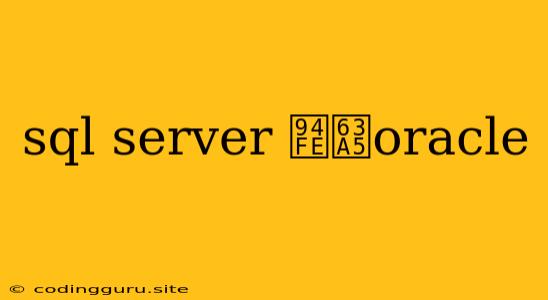How to Connect SQL Server to Oracle: A Comprehensive Guide
Connecting SQL Server to Oracle is a common requirement in many data integration scenarios. This guide will provide a comprehensive overview of how to establish this connection, explore different methods, and address potential challenges.
Understanding the Connection Types
There are several ways to connect SQL Server to Oracle, each with its unique advantages and considerations:
1. Using Linked Servers:
- What is a Linked Server? Linked servers allow you to access data in another database server as if it were a local object within your SQL Server instance.
- How to Create a Linked Server:
- Open SQL Server Management Studio (SSMS).
- Right-click on 'Server Objects' > 'Linked Servers'.
- Choose 'New Linked Server...'
- Provide a name for your linked server (e.g., 'OracleServer').
- Under 'Server type', select 'Oracle'.
- Enter the Oracle server name, port number, and other connection details.
- Specify the Oracle authentication method (e.g., username and password).
- Configure provider settings to ensure compatibility with your specific Oracle version.
- Click 'OK' to create the linked server.
2. Open Database Connectivity (ODBC):
- What is ODBC? ODBC is a standard API that enables applications to access various data sources, including Oracle databases.
- How to Configure ODBC:
- Open the 'ODBC Data Source Administrator'.
- Select 'System DSN' to create a data source for all users or 'User DSN' for individual user access.
- Choose 'Add'.
- Select the 'Oracle' driver from the list.
- Provide the connection information (server name, port, username, password).
- Test the connection and save your ODBC data source.
3. Microsoft Data Access Components (MDAC):
- What is MDAC? MDAC provides a framework for accessing various data sources, including Oracle, through OLE DB.
- How to Use MDAC:
- Use the 'Provider=MSDAORA.1' connection string syntax.
- Specify the Oracle connection details (server name, port, username, password).
4. Third-Party Tools:
- Advantages: Some tools offer seamless integration and advanced features for data transfer and synchronization.
- Examples:
- SQL Server Integration Services (SSIS): Provides a comprehensive solution for data integration tasks.
- Data Transformation Services (DTS): Allows you to move data between different database systems.
Choosing the Right Method
The best method for connecting SQL Server to Oracle depends on your specific requirements:
- Linked Servers: Ideal for querying and retrieving data from the Oracle database directly within SQL Server queries.
- ODBC: Provides a flexible and standard approach for accessing Oracle data from various applications.
- MDAC: Offers a streamlined way to connect and access Oracle databases through OLE DB.
- Third-Party Tools: Best for complex data integration scenarios requiring advanced features and automation.
Key Considerations
- Authentication: Ensure the chosen method supports the authentication mechanism used by your Oracle database.
- Permissions: The SQL Server user accessing the Oracle database must have appropriate permissions for the required operations.
- Data Types: Be mindful of potential data type differences between SQL Server and Oracle, and handle them appropriately.
- Performance: Optimize connections for efficient data transfer and query execution.
Example: Retrieving Data from an Oracle Table
Assuming you have created a linked server named 'OracleServer', the following SQL Server query retrieves data from an Oracle table:
SELECT *
FROM OracleServer.OracleDB.dbo.Customers
Troubleshooting
If you encounter connection issues, review the following:
- Check network connectivity: Ensure your SQL Server instance can communicate with the Oracle server.
- Verify Oracle service status: Confirm that the Oracle service is running and available.
- Validate credentials: Double-check the username, password, and authentication method.
- Review error messages: Examine the error messages for clues about the problem.
Conclusion
Connecting SQL Server to Oracle is essential for data integration and interoperability. This guide provided an overview of different methods, their pros and cons, and key considerations for successful implementation. By choosing the right approach and carefully addressing the potential challenges, you can establish a robust and reliable connection for efficient data access and manipulation.
